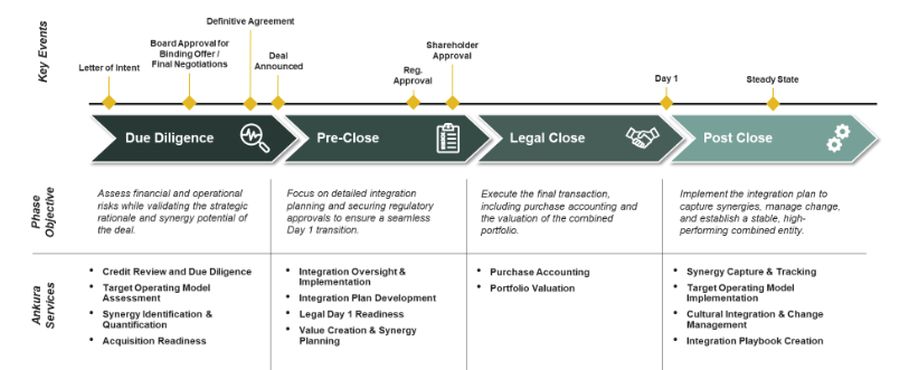- within Finance and Banking topic(s)
- with readers working within the Banking & Credit and Retail & Leisure industries
- within Compliance and Insurance topic(s)
Mergers and acquisitions (M&A) in the financial services sector represent significant strategic undertakings. However, the data highlights a stark reality: nearly two-thirds of all bank mergers fail to create value for shareholders two years after the deal closes.1 While headlines often focus on deal valuation and market synergies, the ultimate success and value realization are determined in the complex post-announcement integration phase. It is here that mismanaged operational details often erode a deal's potential and introduce substantial risk.
From our hands-on experience advising banks through major acquisitions, we have identified four critical challenge areas that consistently emerge. For any leadership team navigating the complexities of an M&A event, addressing these imperatives is fundamental to protecting their investment and achieving the intended strategic outcomes.
Challenge 1: Organizational Governance and Role Clarity
A primary challenge in post-merger integration is the magnification of any pre-existing ambiguity in organizational governance. Under the pressure of combining two distinct entities, unclear lines of ownership can quickly escalate into significant points of failure.
For instance, we observed how uncertainty regarding the ownership of developing and distributing regulatory disclosures, a task falling between the business line and the compliance department, resulted in missed regulatory mailing deadlines. This created unnecessary compliance risk and potential financial penalties. In another case, a lack of clarity between credit risk and administration teams regarding a supplemental loan portfolio review led to a rushed, last-minute analysis just days before the legal close. This could have been avoided if a clear distinction in responsibilities had been addressed at the onset of the planning phase.
A robust governance framework is a foundational requirement for mitigating execution risk. Integration leaders must proactively establish a central Integration Management Office (IMO). This office is tasked with setting a strong tone from the top and developing and owning detailed project plans that explicitly define scope, deliverables, and decision-making authority. This will ensure every critical task has a single owner and all functional areas are clear on the scope of their work. Ankura helps clients establish a robust IMO, setting clear roles and responsibilities for the entire program from day one. Our teams provide hands-on execution support within each workstream, managing senior stakeholders, pushing critical decision-making, and owning and driving the completion of key deliverables. By proactively identifying and resolving roadblocks, we drive forward the mission of the merger and ensure accountability across the organization.
Challenge 2: Third-Party Risk and Contract Management
An acquired entity's portfolio of third-party contracts presents another significant area of risk and potential value erosion. Failing to conduct immediate, thorough reviews and inventory of all vendor agreements can lead to substantial, unforeseen costs that detract from the merger's financial benefits.
Any delayed action from key stakeholders can result in multiple unfavorable vendor contracts being renewed. This can lock the acquirer into paying for redundant and potentially suboptimal solutions for years into the future. For example, we have seen institutions forced to pay for two different fraud prevention platforms or multiple enterprise software licenses when only one was needed. This occurred simply because a clear and timely intent to terminate notice was not issued as part of a coordinated contract management strategy.
Vendor contract review must be a day one priority. A rigorous discovery process is essential to map all existing contractual obligations, renewal dates, and termination clauses. This enables strategic decisions on vendor consolidation, cost reduction, and overall third-party risk mitigation, thereby capturing savings that contribute directly to the deal's success.
Challenge 3: Financial Discipline and Expense Control
The financial rationale for a merger can be quickly undermined by incomplete forecasting and a lack of disciplined expense control during the integration. Initial due diligence often fails to capture the full scope of costs, leading to budget overruns that can alarm leadership and investors.
We have observed several categories of frequently underestimated "hidden costs" that can materially impact a deal's budget, including:
- Security Upgrades: Physical and technical security upgrades to align acquired branches and offices with the parent company's standards.
- Talent Retention: Severance and restricted stock units (RSU) / option packages required to retain or transition key leadership.
- Operational Overtime: Significant overtime costs for hourly employees tasked with executing integration work streams.
- Insurance Premiums: A sharp increase in directors and officers (D&O) insurance premiums post-acquisition.
Financial diligence must extend well beyond the deal's close. Protecting the investment requires creating a dedicated financial work stream with a mandate for meticulous reforecasting, tracking all emergent expenses against the budget, and maintaining a stringent approval process. This discipline ensures transparency and control over the total cost of integration.
Challenge 4: Human Capital Management and Communication
People are the most critical aspect of a successful integration. The post-announcement period is invariably characterized by employee uncertainty, and a failure to develop a communication strategy and plan can lead to the loss of invaluable institutional knowledge and operational continuity.
We observed that a significant delay in notifying the acquired bank's employees of their future employment status created uncertainty. Consequently, several key employees who were slated to take on roles in the future entity proactively sought and accepted external opportunities. This unexpected exodus of talent created critical staffing shortages and operational disruptions following the closure of the deal.
A proactive and comprehensive communication plan is essential for building trust and ensuring organizational stability. Providing clear timelines for decisions, even when definitive answers are not yet available, is far superior to silence. This approach is fundamental to retaining the key talent that underpins the merger's long-term value. To manage this complexity, Ankura utilizes a proven communication calendar as a starting point, which outlines a cadence of messaging for customers, internal teams, and external stakeholders (e.g., investors) from deal announcement through core system conversion. We leverage the communication channels that best maximize awareness and adoption. We then tailor this plan to fit the specific needs of the bank, ensuring a consistent and confidence-building narrative throughout the integration.
Conclusion
The successful integration of two financial institutions is a deliberate outcome, not an accident. It is the result of a proactive, disciplined, and strategic approach to management. By focusing on the core imperatives of establishing clear governance, controlling third-party risk, maintaining financial discipline, and executing a thoughtful human capital strategy, organizations can effectively navigate the complexities of post-merger integration. Addressing these challenges head-on is the key to mitigating risk and fully realizing the strategic promise of the deal.
How Ankura Can Help

Navigating the complexities of a merger integration while running your daily operations is a significant challenge. Ankura brings deep industry knowledge and a proven track record of guiding financial institutions through complex transformations. Our team helps you establish a robust governance model from day one to avoid the pitfalls of unclear ownership. We conduct a rapid, in-depth analysis of third-party contracts to uncover immediate cost-saving opportunities. Our financial experts provide the rigorous expense control and reforecasting necessary to keep your integration on budget. We work with you to develop and execute a human capital strategy that retains your key talent and ensures a smooth transition.
Footnote
1 S&P Capital IQ
The content of this article is intended to provide a general guide to the subject matter. Specialist advice should be sought about your specific circumstances.




